While planning our 5 Week Trip to the Pacific, one country that we’d be visiting seemed far different than the others.
The Solomon Islands is most famous for and mainly visited due to its wealth of World War II sites. While I’m no WWII history buff, I do enjoy the topic. It also just so happened that our visit coincided with a big event, the 75th Anniversary of the Battle of Guadalcanal.
While the Solomon Islands, doesn’t get a ton of travelers, the time we were there it was busy due to the big anniversary. (A couple of war ships were in port, an American and Australian or New Zealand ship.) There were also lots of people on pricey group tours.
Hotels were pretty much full, (there aren’t a ton to choose from) but the sites were still very quiet.
Rather than take a pricey group tour, here is some info on how you can visit the Solomon Islands independently and in a budget-friendly way.
While boarding our flight from Nadi, Fiji on Fiji Airways to Honiara, Solomon Islands, it seemed like Kim and I got a few odd stares. We were the lone family, traveling with young children to the Solomons. It appeared that most of the other people traveling were part of a group, booked on an Australian or US tour. These tours were made up of family members of vets who served on the Solomons during WWII and history buffs.
We arrived late in the afternoon on a Sunday. We settled in to our hostel and then headed out to explore. We soon realized that the island shuts down by around 4:00 pm on Sundays. Good luck finding a restaurant open. Luckily we had some provisions, i.e. peanut butter, cookies, crackers, chips… There are only a handful of restaurants in the Solomons in general.
Travel tip: consider eating at restaurant hotels (something we almost never do). We had decent, reasonably priced meals at a new casino and one of the fancy hotels.
Rather than rent a car, Kim and I decided that it was best to hire a local guide since most of the sites we planned to visit could be hard to locate considering they were in the woods. There’s also a lack of road signs around the island. While we were ready for an adventure, I didn’t need to do it by playing Where’s Waldo with 75 year old World War II relics.
We arranged for a tour with Stanley, a local guy who had recently starting running tours. Stanley met me at our hostel along with one of his brothers during our first night to discuss plans. This was definitely a nice touch. I explained my goals of the visit- to see as many WWII sites as possible. I wasn’t really interested in seeing empty battlefields, I wanted to see the rusty old relics which have been left in place for over seven decades.
On Day 1 we visited some Western sites on the island. We made a quick stop at the Sir Jacob Vouza Memorial which wasn’t what we’d consider exciting…
After a bit of a drive, we pulled into a village where we then had to hike in the woods for around 7-10 minutes. When we got to a clearing, there were some war memorials along with the remnants of this vehicle which I think was used to transport large weapons.
Some of the treads were still intact and there was an old helmet, Japanese water canteen, shovel and other war relics on top.
This was definitely a good introductory site to visit on the island.
Next up was the Vilu War Museum.
When we arrived, nobody was there besides my family, and another couple on our tour. Soon after, three vans pulled up. Around 25 people were visiting with Valor Tours, a company specializing in WWII tours.
The open air museum has an amazing collection, mainly made up of old planes and big guns. Most of the items were brought here from the airport and other battle sites to create the museum.
We spent around 30 minutes here and I could totally imagine these weapons being used during the war- a chilling and scary thought.
The guide from Valor Tours seemed surprised to see us on the island and mentioned how he was impressed to see us traveling independently and with kids. He then gave a quick demo of how the wings on the plane above fold in due to it being a carrier-based plane. (Yes, the wings still move!)
After a lengthy negotiation (most sites are located on private property), we stopped at Bonegi Beach to see the remains of a Japanese freight ship which sunk close to shore. The ship is rusting away but you can still make out the shape of the ship, called the Bonegi II. A few people were snorkeling around the wreck but the water was quiet choppy and I wasn’t about to dive in.
Right across the road and deep in the woods, on what’s hard to describe as a road, sits one of my favorite stops of the trip, a US Sherman tank named Jezebel. (photo at the top of the post)
We spent a lot of time here inspecting the old tank and also climbing around it. We saw bullet holes and an inscription from the manufacturer as well as an old gas can. Stanley’s brother climbed into Jezebel while the other couple and I climbed on top and chatted. Imagine, this tank has been sitting in this spot for 75 years. Insane!
Our final stop of the day would be one of the most bizarre and interesting.
Kurt’s World War II Museum wasn’t listed in any guidebook or online.
The owner, Kurt lives with his family in what used to be an old hotel. The property is like a compound and he even has security. The museum is Kurt’s collection of WWII relics, which he claims to be the largest of it’s kind in the whole country!
Kurt’s grandfather founded an oil or gas company many years back on the Solomon’s so he’s been there his whole life. (His family is from Germany.)
When you pull into the property, you’ll see rows of rusty remnants of guns, buckets of grenades & bullets, shells of all sizes lined up, piles of helmets and more. It’s a fascinating collection to see and Kurt hopes to turn it into a museum one of these days.
Inside, I was amazed to see piles of WWII meal trays, cabinets with dog tags, handguns, and knives with brass knuckles like the one above. Kurt told us to feel free to touch whatever we liked.
Kurt sends locals out into the bush everyday so his collection keeps growing. He even has a plane which was pulled from a swamp being restored in Australia!
Since Kurt’s museum isn’t an official museum, my guess is that you’ll need to ask around to find it.
Day 2 led us on a long drive to the Tetere Beach World War II Museum.
The museum is another of the open-air variety. As you drive along a path through the high grass you’ll immediately spot amtracks, amphibious troop carriers.
Upon arrival at the museum, there’s a table set up with some old soda bottles, a rusty oil can and some pots and pans. The main draw here is the collection of around 30 amtracks which haven’t moved since they dropped troops off here during the war.
I could imagine troops being driven up onto land from the beach and then leaving the vehicles behind where they’re now being taken over by nature. Tetere is definitely a must-visit during a visit to the Solomon Islands.
After a bit of a drive, we then visited a few sites close to Henderson Field. We took a couple of photos by the Japanese Anti-Aircraft Gun in front of the airport before making a quick stop at the Solomon Islands Memorial Gardens. A short drive behind the airport led us to the US WWII Control Tower which from what I recall, our guide Stanley said was rebuilt.
We then drove to a village where we walked through a tunnel which was built by the US during the war. It was interesting to see and actually pretty big inside
 Next up was the Betikama Adventist College Museum and Carvings Shop which has a good collection of remnants of old planes and gas cans outside.
Next up was the Betikama Adventist College Museum and Carvings Shop which has a good collection of remnants of old planes and gas cans outside.
After walking through their shop and past an enclosure with a crocodile, we entered a small museum. Here we saw machine guns, artillery shells and the most interesting part- some siding from a B24D plane with the partial remainder of a color painting, “Blondie” on it.
Our final stop of the day was the Guadalcanal American Memorial. Early in the morning, there was a big ceremony to commemorate the 75th anniversary which we did not attend.
The memorial is filled with lots of info which I read while Lucas walked around with our guide Stanley. The most interesting part of the site was a huge star in the middle which has some small remains from The Unknown Warrior, an American soldier found while the site was being excavated.
While wandering around during our last day on the island, we made a quick visit to the small but very interesting National Museum. It’s free to enter and it’s worth a visit.
The museum is one large room with some interesting displays about culture, currency and the local people’s role during WWII.
Overall, our visit to the Solomon Islands was very interesting and also very different than all of the other island we visited during our trip. The focus is primarily on WWII of which the people are proud and also thankful to the US for helping them during the war.
If you’re looking to visit the Solomon Islands and need a guide, I highly recommend Stanley. You can e-mail him at st09travels@gmail.com or call #8523706.
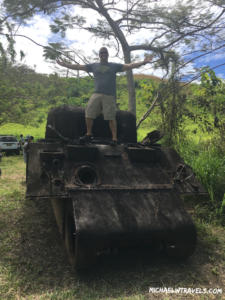
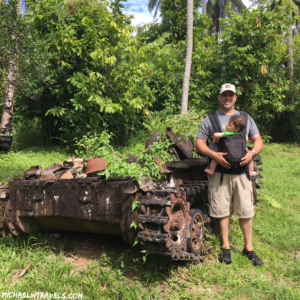
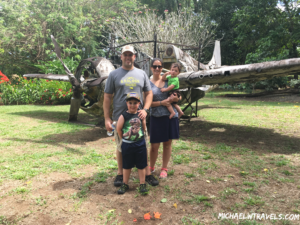
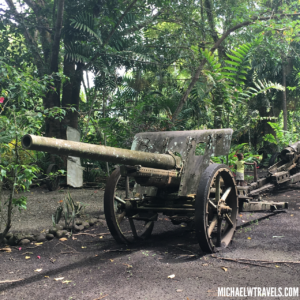
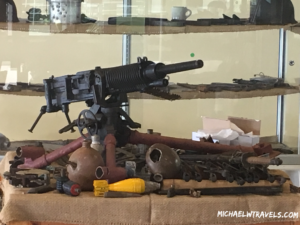
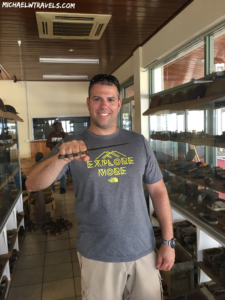
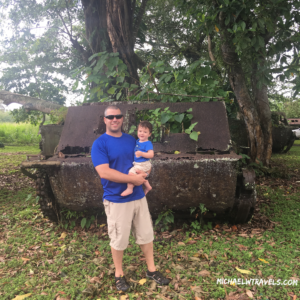
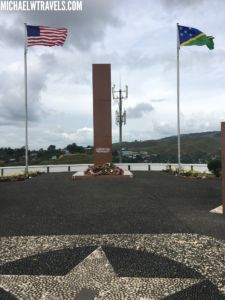
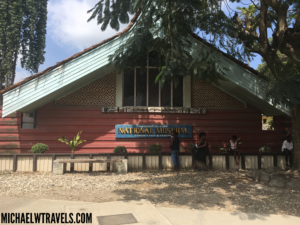
Hi. How do you go with travelling in cars with young children. Did u take your own car seats? Many thanks theres